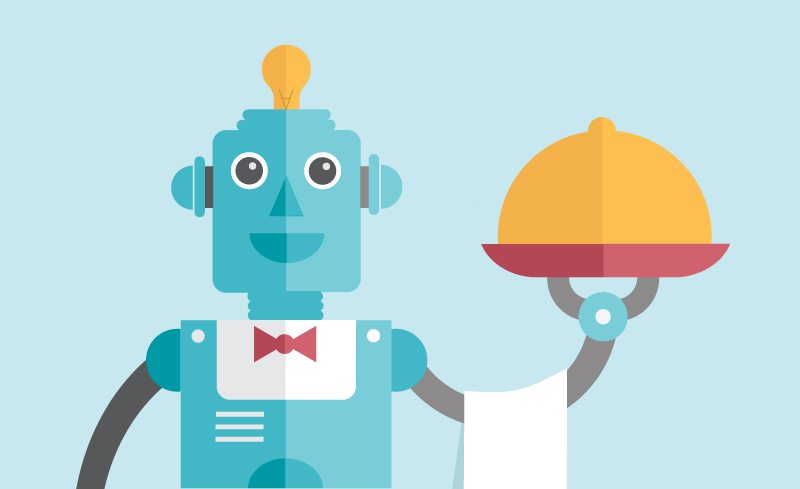Alexa and Google Home transmute the definition of the word “virtual assistant”. What does this mean for the future of AI-assisted chatbots and chat simulators?
You may have imagined an “AI future” to be something akin to I, Robot or even Ghost in the Shell. But what we have now are still developing self-driving cars, dog robots, and Sophia. And, of course, we also have a ton of chatbots.
While chat simulators may not be the AI future we imagined, it is the AI present we have.
Chatbots and virtual assistants are becoming much more commonplace in everyday life. Many companies leverage them in various ways, especially when it comes to marketing. But the future implications of AI-assisted chatbots go much further than marketing.
Companies are working, right now, to transform chatbots into tools for humanitarian causes. One app even released their source code in an effort to spur AI-assisted chatbot development and research.
What is the future of chat simulators, chatbots, and virtual assistants?
Chat Simulators as Marketing Tools
Incorporating chatbots into your business model might be easier than you think.
The simplest way is by using them as an option for customer support and chat services. After all, chatbots don’t need sleep like humans do. This also means that your business can scale more smoothly.
You can create your own chatbot using Dexter by giving it operation protocols. But it is the incorporation of AI that transitions a chatbot from “bot” into an assistant.

A great example of this is Resistbot. Jason Putorti helped develop Resistbot as a tool in the fight for Net Neutrality. The tool mainly serves as a way to contact government officials in the U.S.
The trick here is the way in which Resistbot interacts with people. It feels authentic and sincere as opposed to canned or pre-programmed.
Automation is a great tool for social media marketing, but without a human touch, it can easily fall flat.
Chris Parbey, Jr., our resident marketing expert, covered this in 2017 discussing ways to boost social media engagement using chatbots. I also covered ways to incorporate chatbots in March of this year.
We both touched on how versatile chatbots and chat simulators are. But we also address the fact that working with voice search and AI like Alexa is important. These AI assisted chatbot assistants operate similarly to Resistbot.
If you want to automate your marketing using chatbots, get to know virtual assistants first.
Virtual Assistants: Not Just Humans Working Remotely
A chat simulator is useful if you are simply trying to offer customer service. A chatbot with AI assistance is an entirely different class of bot.
This plays into the job we know as “virtual assistant” where a person or company works remotely to assist you. You can find tutorials on how to become one online and companies that offer VA services.
What virtual assistants do can include many things such as:
- Responding to incoming phone calls, call transfers, and related tasks
- Social media marketing services
- Email marketing, lead generation, and blogging
- In-person networking and cold calling
- Accounting and bookkeeping
- Internet research
- Data entry and data interpretation
- Schedule and time management
This is where products like Siri, Alexa, and Google Home come in since they are also assistants. With the support of AI algorithms, they could one day do all of these things.
You can already use Google Home to set various calendar reminders, control the lights in your house, and more. Google even set up an entire website where you can search more than 1 million tasks.
Adapting chatbots to work in other languages is one of the first steps to transitioning voice search into virtual assistants. This step could also transform voice search and AI-assisted chatbots into more than assistants.
Virtual Assistants As Humanitarian Tools
A new app seeks to forge AI assisted chatbots into humanitarians.
Capiche, the AI based translator and tracing service, wants to leverage crowdsourcing and an algorithm to help refugees. This app uses crowdsourced data to teach the AI system and is a peer of another EIT Digital innovation.
The European Refugee Information and Communication Service (ERICS) can use Capiche to help refugees learning or getting used to new languages. In time, Capiche will offer real-time multilingual communication for all major EU languages. The company cited its goals as this:
- Real-time language translation: English, Persian, German, Arabic, and more
- Crowdsourced review of legal documents
- Fact checking and extremist/fake news filter
- Transference of public facilities and location information understood in foreign languages
But this isn’t the only way AI and people are assisting each other in the present day.
AI-Assisted Chatbots as Part of Everyday Life
Sophia was certainly a shock for some (watch above as things get awkward fast with actor Will Smith). But this kind of robot implementation is only the beginning.
Just take a look at this lifelike robot that is now a news anchor in Japan.
Since we have covered stories about her before, you might know about Erica the robot. But now, the 23-year old Japanese female appearing robot has a job. She recites scripts on-air and interacts in real time with other humans.
Originally conceived to be a receptionist, Erica the android utilizes facial recognition, infrared sensors, and speech recognition. She can hold conversations and read facial expressions, but she does not yet have an independent mind.
Despite this fact, Erica displays another facet of AI-assisted chatbots: companionship. Enter the chatbot creation app Replika with more than 2 million downloads.
My Invisible, No Longer Imaginary Best Friend
Some of us might have had “imaginary best friends” when we were growing up. We would tell them everything and share experiences with them. Some of us might have also seen the movies Her or Lars and the Real Girl.
Even Blade Runner 2049 featured commentary on AI companions with the character Joi.
Though the app Replika can’t produce a lifelike hologram, it can provide companionship. In it, you create your own chatbot which uses a neural network to maintain conversations.
Over time, it learns speech patterns from the user and its main purpose is to talk. It doesn’t have many other functionalities, but the creators released the code with an open source license.
That means that other developers can employ the CakeChat AI engine for new endeavors.
You might recall a similar Google chatbot from 2015 trained on movie scripts. But the Replika neural network seems focused on person-to-person interaction.
Perhaps this and 3D printing are what lead to that one episode of Black Mirror with Hayley Atwell and Domhnall Gleeson.
In it, a neural network imitates a person based on their actions on the internet and social media. This gets put into a body of non-descript origins that impersonates the (dead) person further. If you haven’t seen the episode “Be Right Back”, I highly recommend it.
But there is a thought scarier than AI impersonating replicas of your loved ones. AI-assisted chat simulators and all AI may not be on the track to true artificial intelligence.
Counterpoint: What if all Current AI is Totally Wrong?
Many people regard Geoffrey Hinton as the “godfather of AI” due to his work in the 1980s. He takes issue with a concept he helped create. That concept is one called “back propagation” and it is how most neural networks “learn”.
He contends that, because AI uses machine learning based on human inputs, they are not truly intelligent. “True intelligence”, according to Hinton, comes from spontaneous thought and “unsupervised” learning.
If Hinton is right, AI-assisted chatbots may not beyond Erica the android and Resistbot.
So, depending on who you ask, we’re either on the verge of virtual assistants gaining human-level intelligence or we’re about to hit a big wall in the metaphysical definition and idea of intelligence. In either case, I’m just glad the robot butlers are here to stay.



















Comments (0)
Most Recent